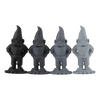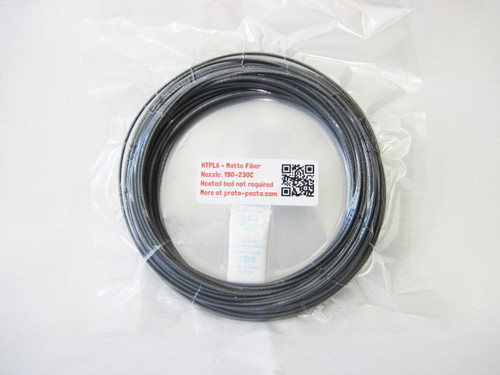- All material is sealed with desiccant in a plastic bag
- Usable on all PLA-compatible printers, such as Makerbot, Ultimaker, Printrbot, Lulzbot, and more!
- Size: 1.75mm
- Weight: 500g
Product Description
For exceptional accuracy, finish & performance, choose Carbon Fiber
Proto-pasta Carbon Fiber Composite HTPLA is a combination of milled carbon fibers & high-performance PLA. Resulting 3D printed prototypes & end-use parts are characterized by exceptionally form stability up to 160 deg C (320 deg F) when heat treated.
Filament specs:
- Base material: Heat treatable PLA with higher temperature resistance
- Characteristics: low odor, non-toxic, renewable-sourced biodegradable polymer
- Molecular structure: Amorphous "as printed", partially crystalline when "heat treated"
- Additives: 10% by weight high-purity, milled carbon fiber
- Max particle size: 0.15 mm (may limit nozzle size & layer thickness)
- Density & length: 1.3 g/cc for 360 m/kg (1.75) & 136 m/kg (2.85) lengths
- Min bend diameter: 40 mm (1.75) & 100 mm (2.85)
- Glass transition (amorphous "as printed" material use limit): approx. 55 deg C
- Melt point (crystalline "heat treated" material use limit): approx. 170 deg C
- Note that melting resets heat treated material to amorphous "as printed" state
- Min temp to avoid jamming @ 1.5 cubic mm/s: approx. 215 deg C
- Min temp to avoid jamming @ 9 cubic mm/s: approx. 235 deg C
- Temp to overcome jamming on Prusa MK3 at start of print: 255 deg C
- Min recommended volume flow @ 240 deg C: 1.5 cubic mm/s (e3d v6)
- Max recommended volume flow @ 240 deg C: 9 cubic mm/s (e3d v6)
- Volume flow = extrusion width x layer height x speed in mm
- For example 0.5 mm extrusion width & 0.2 mm layer height for speed 20-90 mm/s
- Max use temp: 50 deg C "as printed", 160 deg C when "heat treated"
- Application-specific use limits are geometry, load & condition dependent
- Typical heat treating conditions: 110 deg C (225 deg F) for 30 min
- A large range of temperatures & times can yield acceptable results
- Typical dimension change when heat treating: 0.6% x/y shrink, 1% z growth
- Scale for slicer when heat treating: 1.006 or 100.6% x/y, 0.99 or 99% z
Printer requirements:
- Must accept 3rd party filament (not cartridges)
- Must allow nozzle replacement & parameter adjustment
- Heated bed not required, but up to 60 deg C recommended
- Filament path must not bend tighter than min bend diameter
Packaging:
- Available in 1.75 & 2.85 (3.00) mm diameter
- 50 g loose coil, 500 g on cardboard spool & 3 kg on plastic spool
- Cardboard spools are 90g weight & 20 cm dia x 6 cm wide w/ 5 cm opening
- Carefully remove cardboard spool sides for Masterspool compatibility - recycle locally
- 3kg spools are 1kg weight & 30 cm dia x 10 cm wide w/ 5 cm opening - return spools for re-use
- Hold filament end when unwrapping spool to avoid looping
- Do not bend tighter than min bend diameter
- When done printing, secure filament end to avoid looping
- Store in cool, dry place away from UV light for peak performance
Printing recommendations:
- Clean print surface with alcohol or water using adhesion aid if required
- Carefully control first layer gap for adhesion without jamming
- Print within volume flow range to ensure full melting of material
- Nozzle diameter limited by volume flow limits & max particle size
- Layer thickness limited by volume flow limits & max particle size
- Speed limited by volume flow limits & nozzle temperature
- Adjust extrusion multiplier or flow as required for accurate extrusion width
- Replace nozzle when worn
- Max layer fan after 1st layer for best surface quality w/ short layer times
- Isolate/insulate heater block from layer fan for consistent heating
More about HTPLA & heat treating:
HTPLA is a semi-crystalline grade of PLA optimized for heat treating (also known as annealing or crystallizing) for higher temperature use. Without heat treating, "as printed" amorphous PLA loses significant stiffness (and the thus the ability to retain form) as the material approaches it's relatively low glass transition temperature. Heat treating creates a more crystalline molecular structure for maintaining stiffness to near melting, thus extending the useful range of HTPLA, but also creates shrinkage. HTPLA parts should be scaled in slicer to compensate for shrinkage when heat treating.











